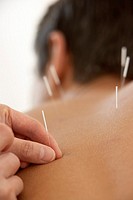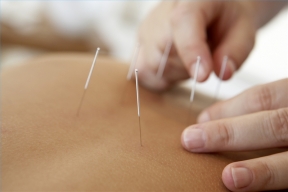Dry Needling
At Revive we offer "Western Acupuncture" or dry needling as an adjunct to physiotherapy and massage treatments.
 Dry needling is the Western method of needling adopted from acupuncture, and is based on the physiological response achieved and has
evidenced based practice to promote its efficacy.
Dry needling is the Western method of needling adopted from acupuncture, and is based on the physiological response achieved and has
evidenced based practice to promote its efficacy.
Dry needling is an effective way of eliminating trigger points in tight muscles. Dry needling points overlap with traditional acupuncture
points as approximately 80 per cent of acupuncture points correspond to trigger points in muscles. Dry needling varies from acupuncture with
the needling technique used. A needle is inserted onto the palpable taut tender band of muscle. The clinician will feel an increased
resistance to the needle in the area of the trigger point, the needle will then be withdrawn slightly and introduced into the taut band in
differing areas along the trigger point producing a “twitch” response.
What can dry needling help?
- Headaches
- Lower back pain/sciatica
- Frozen shoulder
- Tennis elbow
- Achilles tendonitis/tendinopathy
- Sports injuries
- Arthritis
- Repetitive strain injury
- Neuralgia
- Post stroke
- Bursitis
Following the assessment your clinician will determine which method is most appropriate for your condition.  What is a trigger point ?
What is a trigger point ?
An active trigger point is a hyper irritable spot in skeletal muscle that is associated with a hypersensitive palpable nodule in a taut band
of muscle. These muscles often appear tight, weak, do not respond to stretching and cause restricted joint range of motion. On compression,
trigger points are exquisitely tender and can give rise to distinctive referred pain patterns and or a local muscle twitch response, or a
whole body jump response. Dry needling is a very effective method of relieving trigger points.
Trigger points in muscles can be caused by emotional stress, postural strain, trauma, fatigue, altered breathing patterns, sleep deprivation, infections and mineral deficiencies. Once a trigger point is established it can become self perpetuating and persist for decades until it is adequately released. If the trigger point is not released it can lead to altered joint motion and be the cause of recurring neck, hip and low back pain for example.
.svg)